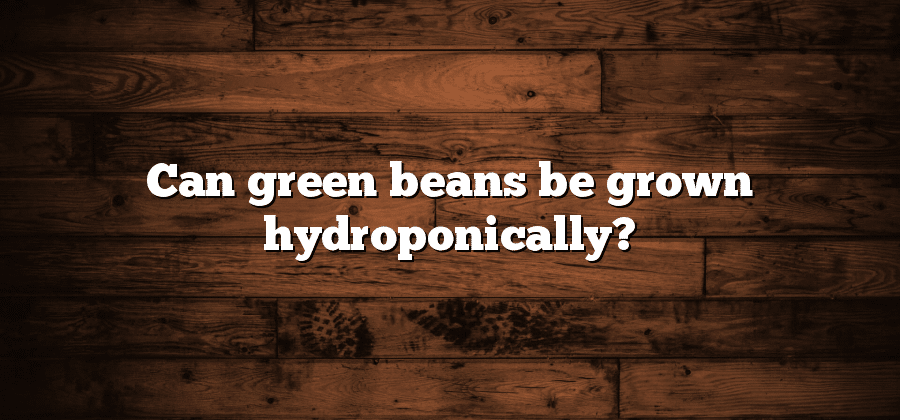Hydroponic Growing Systems for Green Beans
There are several hydroponic growing systems that can be utilized for green bean cultivation. One of the most common and straightforward systems is the nutrient film technique (NFT). In this system, a shallow, sloping channel is used to deliver a thin film of nutrient-rich water to the plant roots. Another option is the deep water culture (DWC) system, where the green bean plants are suspended in a nutrient solution, allowing their roots to directly access the water and nutrients. Lastly, there is the ebb and flow system, which involves periodically flooding and draining a container or tray with nutrient solution, providing the green bean plants with intermittent access to water and nutrients. Each of these hydroponic systems has its own advantages and considerations, and the choice depends on factors such as space availability, resource availability, and grower preferences.
When setting up a hydroponic growing system for green beans, it is important to ensure that the plants receive adequate light, water, and nutrients. Light is essential for the photosynthesis process, and it is recommended to provide the green bean plants with at least 12-16 hours of light per day. As for water, it should be clean and free from contaminants such as chlorine or heavy metals, which may hinder plant growth. Monitoring and adjusting the nutrient solution is crucial to provide the green bean plants with the necessary macro and micronutrients for healthy growth. Depending on the hydroponic system used, it may be necessary to regularly monitor and maintain the pH and nutrient levels in the system to prevent any imbalances that could negatively affect plant growth.
Advantages of Hydroponic Cultivation for Green Beans
Hydroponic cultivation offers numerous advantages for the cultivation of green beans. First and foremost, this method allows for optimal control of nutrient delivery to the plants. Nutrients are measured and precisely administered, ensuring that the plants receive the perfect balance for their growth and development. This helps in maximizing the yield and quality of the green beans.
Another significant advantage of hydroponic cultivation is the efficient use of water and nutrients. By growing green beans without soil, the plants have direct access to water and nutrients, resulting in reduced wastage. This makes hydroponics an environmentally friendly option as it significantly conserves resources. Moreover, the controlled environment in hydroponic systems helps in preventing the growth of weeds and the occurrence of diseases, leading to healthier and more vigorous plants.
In conclusion, hydroponic cultivation for green beans offers significant advantages in terms of nutrient control, resource efficiency, and disease prevention. These benefits contribute to higher yields and superior quality beans, making it a highly favorable method for both commercial and home growers.
Suitable Varieties for Hydroponic Green Bean Cultivation
When it comes to hydroponic green bean cultivation, selecting the right variety is essential for achieving optimum growth and yield. There are several suitable varieties available that are specifically adapted to hydroponic growing systems.
One popular variety is the Provider green bean. Known for its high productivity, Provider beans produce abundant harvests of tender, stringless pods. This variety is also known for its resistance to common bean diseases, making it a reliable choice for hydroponic cultivation. Another excellent option is the Maxibel green bean. With its long, slender pods and crisp texture, Maxibel is prized for its excellent flavor and visual appeal. This variety is well-suited to hydroponic systems due to its upright growth habit and high disease resistance.
Essential Nutrients for Hydroponic Green Beans
Green beans are a highly nutritious and delicious addition to any diet. When cultivating them in a hydroponic system, it is essential to ensure they receive the necessary nutrients to thrive. These essential nutrients can be divided into two categories: macronutrients and micronutrients.
Macronutrients are nutrients that plants require in large quantities to support their growth and development. The primary macronutrients for hydroponic green beans are nitrogen (N), phosphorus (P), and potassium (K). Nitrogen is responsible for promoting leafy growth, while phosphorus aids in root development and flowering. Potassium, on the other hand, contributes to overall plant health and disease resistance. Balancing the macronutrient levels in the hydroponic solution is crucial to maintaining healthy green bean plants.
Micronutrients, on the other hand, are essential trace elements that plants need in smaller quantities. Some of the micronutrients necessary for hydroponic green beans include iron (Fe), zinc (Zn), manganese (Mn), and copper (Cu). These nutrients play a vital role in various metabolic processes, including photosynthesis and enzyme activation. Although plants require smaller amounts of micronutrients, their absence or deficiency can have a significant impact on plant health and productivity. Providing a well-balanced mix of both macronutrients and micronutrients is key to optimizing hydroponic green bean cultivation.
pH and Temperature Requirements for Hydroponic Green Beans
Maintaining the appropriate pH and temperature levels is crucial for the successful cultivation of green beans in a hydroponic system. The pH level refers to the acidity or alkalinity of the nutrient solution, which directly affects the absorption of essential nutrients by the plants. For optimal growth, green beans prefer a slightly acidic pH range of 5.5 to 6.5. This range ensures that the nutrients are readily available to the plants and promotes efficient nutrient uptake. Regular monitoring and adjustment of the pH levels are necessary to prevent nutrient deficiencies and imbalances.
In addition to pH, maintaining the right temperature is equally important for the healthy development of hydroponic green beans. These plants thrive in a temperature range of 70°F to 80°F (21°C to 27°C) during the day, while slightly lower temperatures of around 10°F (6°C) lower are ideal during the night. Extreme temperature fluctuations can stress the plants and affect their growth, so it is essential to provide a stable and controlled environment. Proper insulation and the use of heating or cooling systems, if necessary, can help maintain the optimal temperature range and promote optimal growth and yield of hydroponic green beans.






